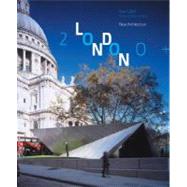
London 2000+ New Architecture
by Lubell, Sam; Livingstone, KenBuy New
Rent Book
Used Book
We're Sorry
Sold Out
eBook
We're Sorry
Not Available
How Marketplace Works:
- This item is offered by an independent seller and not shipped from our warehouse
- Item details like edition and cover design may differ from our description; see seller's comments before ordering.
- Sellers much confirm and ship within two business days; otherwise, the order will be cancelled and refunded.
- Marketplace purchases cannot be returned to eCampus.com. Contact the seller directly for inquiries; if no response within two days, contact customer service.
- Additional shipping costs apply to Marketplace purchases. Review shipping costs at checkout.
Summary
Author Biography
Sam Lubell is the Los Angeles correspondent for the Architect's Newspaper and has written for Architectural Record, the New York Times, New York Magazine, the Los Angeles Times, and elsewhere. He is also the author of Paris 2000+: New Architecture.
Ken Livingstone, mayor of London and a former member of Parliament, is committed to a progressive urban plan for the city's infrastructure and environment. The author lives in Los Angeles.
Table of Contents
| Foreword | |
| Introduction | |
| Dance Centre /2003 | |
| Tonkin Liu Roof Garden Apartment / 2007 | |
| David Chipperfield Gormley Studio / 2003 | |
| Foster + Partners 30 St. Mary Axe / 2004 | |
| David Adjaye Rivington Place / 2007 | |
| John McAslan + Partners The Roundhouse / 2006 | |
| Allford Hall Monaghan Morris Barking Central Library / 2007 | |
| Sarah Wigglesworth Siobhan Davies Dance Studios / 2006 | |
| Allies and Morrison Royal Observatory Redevelopment / 2007 | |
| Building Design Partnership Hampden Gurney School / 2002 | |
| Deborah Saunt David Hills Architects John Perry Children's Centre / 2003 | |
| Alison Brooks Architects Wrap House / 2005 | |
| Amin Taha Architects Gazzano House / 2005 | |
| Rogers Stirk Harbour + Partners Lloyd's Register / 2000 | |
| Peter Barber Architects Donnybrook Quarter / 2005 | |
| Studio Daniel Libeskind London Metropolitan University Graduate Centre / 2004 | |
| Haworth Tompkins Young Vic Theatre / 2006 | |
| Sanei Hopkins Architects and Hughes Meyer Studio Artist's Studio / 2004 | |
| Niall McLaughlin Architects Peabody Trust Housing / 2004 | |
| Marks Barfield London Eye / 2000 | |
| De Rijke Marsh Morgan Architects Kingsdale School / 2006 | |
| Keith Williams Architects Unicorn Theatre / 2005 | |
| SMC Alsop Peckham Library / 2000 | |
| Birds Portchmouth Russum Plashet School Footbridge / 2000 | |
| Featherstone Associates South Essex Rape and Incest Centre / 2005 | |
| Make Architects 55 Baker Street / 2008 | |
| Spacelab UK Great Ormond Street Hospital Orangery / 2004 | |
| Surface Architects Lock-keeper's Cottage / 2005 | |
| Wilkinson Eyre Floral Street Bridge / 2003 | |
| Locations of Featured Projects | |
| Table of Contents provided by Publisher. All Rights Reserved. |
Excerpts
By Sam Lubell
London's recent buildings are some of the most vibrant in the world. From the daring shape-making of Norman Foster's 30 St. Mary Axe, more familiarly known as the Gherkin, to the cool, layered artistry of David Adjaye's Rivington Place, these projects are internationally admired and have played an important role in the city's conversion from an architectural backwater to a world capital of contemporary design.
Economic growth, resurgent popular interest in architecture and design, heightened political and nonprofit support and funding, and London's relatively new status as Europe's creative and financial melting pot have all contributed to this radical shift. Taking advantage of this climate, a group of talented firms are creating unique, artful projects that derive inspiration from contemporary forms and technologies, the city's glorious urban chaos, its fascinating collision of history and modernity, and its palpable energy. They range in scale from tightly-fit house additions to skyline-altering towers.
As recently as the 1980s and early 1990s, the architectural situation did not seem promising: government support was declining, development funds were low, and traditionalists were railing successfully against innovation. As architect Peter Barber confesses, “At cocktail parties, London architects were not proud to tell you what they did.” But in the mid-1990s a perfect architectural storm began to brew. England's economy began to recover and then to thrive, spurring an unprecedented level of building and a phalanx of cranes to rise high above London's historic spires. Popular interest in, and acceptance of, innovative architecture reached new heights as sleekly designed consumer products gained cachet, as architecture began being covered in the mass media—bestowing celebrity status on architects—and as controversial buildings became popular conversation starters.
Excerpted from London 2000+: New Architecture by Sam Lubell
All rights reserved by the original copyright owners. Excerpts are provided for display purposes only and may not be reproduced, reprinted or distributed without the written permission of the publisher.
An electronic version of this book is available through VitalSource.
This book is viewable on PC, Mac, iPhone, iPad, iPod Touch, and most smartphones.
By purchasing, you will be able to view this book online, as well as download it, for the chosen number of days.
Digital License
You are licensing a digital product for a set duration. Durations are set forth in the product description, with "Lifetime" typically meaning five (5) years of online access and permanent download to a supported device. All licenses are non-transferable.
More details can be found here.
A downloadable version of this book is available through the eCampus Reader or compatible Adobe readers.
Applications are available on iOS, Android, PC, Mac, and Windows Mobile platforms.
Please view the compatibility matrix prior to purchase.
